1890 Railway Parcel Stamps.
Small parcels were also carried by rail. The two stamps below were especially issued for this purpose. The design of these stamps was similar except the crown was replaced with a coat-of arms.
3d Black. 6d Green.
1890 Railway Freight Stamps.
When larger items were carried by rail they came under the description of "Freight." Another two larger values were issued for this purpose. These stamps were the same as the parcel stamps above except the word "Parcel" was replaced the word "Freight."
1/- Blue. 5/- Red.
While these three sets of stamps were each designed for a particular purpose, it was not uncommon to see them used together to make up the required charge for an item being carried. For example if a parcel cost 8d, a 6d Green parcel, and a 2d Blue newspaper could be used. This interchanging of stamps eventually led to a general set of Railway Charge Stamps being produced to cover all railway changes.
1904 Railway Parcel Stamps - Essays.
(Trials Not Used)
In 1904 New Zealand Railway authorities proposed a new set of railway parcel stamps. They were called Parcel Stamps but I believe the intention they would be an 'all purpose' series designed to cover all smaller Railway Charges. A full set of six values (½d, 1d, 2d, 3d, 6d, and 1/), each with a different design, was commissioned, and essays were printed in various colours. All six values and at least ten colours are shown below. I am unsure why they were never issued and why they all carried the word 'postage.'
NZ Rail Essay - ½d Violet. NZ Rail Essay - 1d Blue. NZ Rail Essay - 1d Red.
NZ Rail Essay - 2d Brown. NZ Rail Essay - 2d Red.
NZ Rail Essay - 3d Blue. NZ Rail Essay - 3d Orange. NZ Rail Essay - 3d Red.
NZ Rail Essay - 6d Brown. NZ Rail Essay - 6d Red. NZ Rail Essay - 6d Violet.
NZ Rail Essay - 1s Green. NZ Rail Essay - 1s Pink. NZ Rail Essay - 1s Red.
1921 Railway Charge Stamps
(Covering all charges).
In 1921, the older 1890 sets above were replaced with this "general purpose" set of 13 values. These stamps were a taller portrait shape when compared with the older ones 1890 stamps. The value has been moved to appear boldly in the centre surrounded by the words, "N.Z.R. Railway Charges." The crown takes the centre-top position with a train design in each corner.
The bulk of the set was printed in 1920 but not released until 1925. The 1d exists (as shown) both with and without "stop" ( period) under the "d". The ½d was issued in 1927, the 8d and 10/ in 1926. The reason for the 8d is interesting - to ship a bushel of fruit cost that amount and to spare the clerks having to use a 6d and a 2d they issued the 8d! The ½d was for newspapers only. As not many of the 8d, 5/- & 10/- were used they have become very rare now.
In a effort to prevent illegal use of these stamps they were over printed with the station name they were sold from. Anyone using these stamps at another station would need to provide a good reason why.
This system of issuing railway charge stamps eventually ceased. As time went by, most smaller parcels were sent by NZ Post and larger items carried by railways would be invoiced in a normal manner. This meant railway charge stamps were no longer required and they were discontinued in 1959.
1/2d Black.
1d Violet. (No Stop) 1d Violet.
Notice the variety of this value on the left. The large full stop under the "D" is missing.
2d Blue. 3d Yellow. 6d Green.
8d Yellow-Green. 9d Red-Brown.
Out of all these stamps the 8d, being only used to a single purpose, has become extremely rare.
1/- Brown. 1/6 Dark Blue.
2/- Pink. 2/6 Grey.
5/- Crimson. 10/- Plum.
The two highest values in this series were never as common and good examples are rarer than with other values in this set.
To interesting varieties of station overprints. I called these varieties because I'm not sure they could be called errors.
Left-hand - The station name appears three times on one stamp.
Right-hand - In this pair the station name is inverted, overprint top to the right then overprint top to the left.
1926 Railway Mail Tag for Fox Films Corporation, specially created for Rail Transport.
Sent from Wellington to New Plymouth, 1/- brown X 3, 5/- red Railway Charges on back with the address on the front.
1928 Railway advertising Mail Tag New Zealand Express Company with 1/6 blue Railway charge tied on back, with a Palmerston North overprint.
There was another set of stamps regularly used on parcels carried by the Railways. These were the stamps of a private company New Zealand Express and have been included in their own post.
Some images on this page were sourced from web site of NZ Revenues.














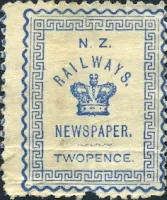


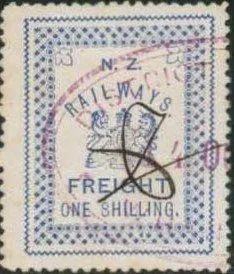











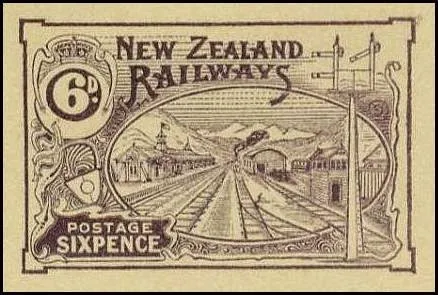
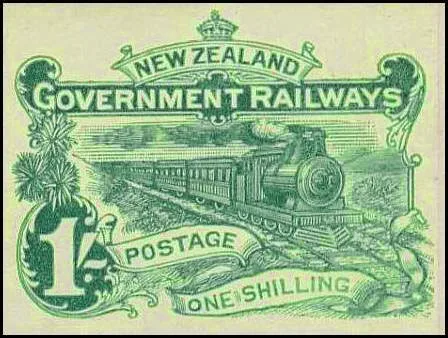


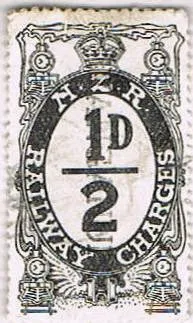
.jpg)


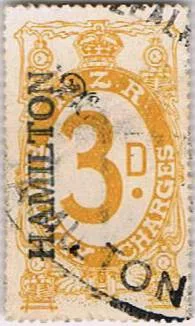
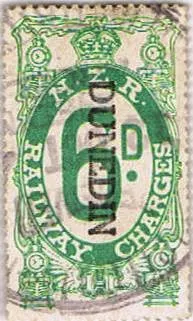










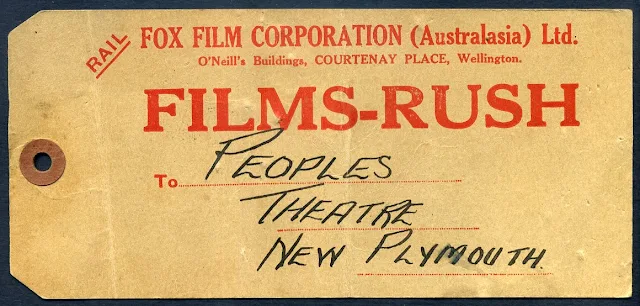


Oh these are great classic stamps.
ReplyDeleteThey are hard to come by and it looks like you have the whole set here.
Mary
Yes I do have the whole set now. Today I have also included a 1904 set that was never used.
DeleteAllan
That 1904 set is interesting. I have never seen those before.
DeleteIn fact these charge revenue stamps are all a new territory of me. I do have an extensive collection of classic stamps including Full Faced Queens. I have not bothered with anything beyond 1967 except for stamp featuring the Royal Family.
I notice you seen to favour Royal Stamps too Allan. I've been visiting your blog for quite sometime now but neber commented until my one above.
Mary
Thanks Mary,
DeleteYes I had never got into Revenue stamps until I added some to my Railway collection. They seem to be an interesting subject. Well worth doing a few more blog posts on.
Yes I do like Royal Stamps. They can often tell a story too which I like. Usually have great photos too.
You must have an impressive collection Mary.
Allan.
Do you know why that 1904 set was never issued? They look like great stamps, particularly the 2d one. Main-trunk viaducts by the look of it.
DeleteMary.
Allan, did you know there was a New Zealand company that issued stamps for parcels carried by trains on NZ Rail. I think their name was Campbell and Crust Ltd. around 1900 I think.
DeleteMary.
Thanks Mary,
DeleteI had a good look at them. Yes it is worth adding them to this blog.
Not sure if I should include them here or do a separate post.
Allan.
Do you know enough about them for a separate post?
DeleteI have a bit of writing about them. Not much really. But there are only six stamps, plus the service one. Is that enough?
Might be better just to dump them here on this page.
Mary
Hi Allan, I have a Hastings NZR 8D and was just wandering whether you've ever come across one before and if so how much they sell for? Best wishes, Tom.
DeleteAs a rough guide $NZ $150 mint $75 used.
DeleteNow can I ask you a question. How did you find this page?
Allan
my stamp collecting forum Allan http://www.stampcommunity.org/topic.asp?TOPIC_ID=51551
ReplyDeleteTom.